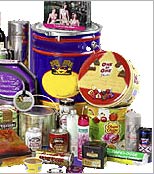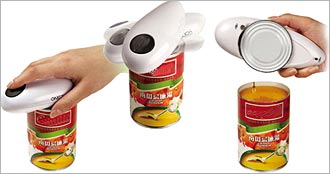Metal Containers
Ancient boxes and cups, made from silver and gold, were much too valuable
for common use. Metal did not become a common packaging material until other
metals, stronger alloys, thinner gauges and coatings were eventually
developed.
One of the "new metals' that allowed metal to be used in packaging was
tin. Tin is a corrosion-resistant metal, and ounce-for-ounce, its value is
comparable to silver. However, tin can be "plated" in very thin
layers over cheaper metals, and this process made it economical for
containers.
The process of tin plating was discovered in Bohemia in 1200 A.D., and cans
of iron coated with tin were known in Bavaria as early as the 14th century.
However, the plating process was a closely guarded secret until the 1600s.
Thanks to the Duke of Saxony, who stole the technique, it progressed across
Europe to France and the United Kingdom by the early 19th century. After
William Underwood transferred the process to the United States via Boston,
steel replaced iron, which improved both output and quality. The term 'tin
can' referred to a tin-plated iron or steel can and was considered a cheap
item. Tin foil also was made long before aluminum foil. Today many still
refer to metal cans as 'tin cans' and aluminum foil as 'tin foil', a
carryover from times well past.
In 1764, London tobacconists began selling snuff in metal canisters,
another type of today's "rigid packaging." But no one was willing
to use metal for food since it was considered poisonous.
The safe preservation of foods in metal containers was finally realized in
France in the early 1800s. In 1809, General Napoleon Bonaparte offered
12,000 francs to anyone who could preserve food for his army. Nicholas
Appert, a Parisian chef and confectioner, found that food sealed in tin
containers and sterilized by boiling could be preserved for long periods. A
year later (1810), Peter Durand of Britain received a patent for tinplate
after devising the sealed cylindrical can.


Since food was now safe within metal packaging, other products were made
available in metal boxes. In the 1830s, cookies and matches were sold in
tins and by 1866 the first printed metal boxes were made in the United
States for cakes of Dr. Lyon's tooth powder.
The first cans produced were lead-soldered by hand, leaving a 1 1/2-inch
hole in the top to force in the food. A patch was then soldered in place but
a small air hole remained during the cooking process. Another small drop of
solder then closed the air hole. At this rate, only 60 cans per day could be
manufactured.
In 1868, interior enamels for cans were developed, but double seam closures
using a sealing compound were not available until 1888.
Aluminum particles were first extracted from bauxite ore in 1825 at the
high price of $545 per pound. When the development of better processes began
in 1852, the prices steadily declined until 1942, when the price of a pound
of aluminum was $14. Although commercial foils entered the market in 1910,
the first aluminum foil containers were designed in the early 1950s while
the aluminum can appeared in 1959.

The invention of cans also required the invention of the can opener!
Initially, a hammer and chisel was the only method of opening cans. Then in
1866, the keywind metal tear-strip was developed. Nine years later (1875),
the can opener was invented. Further developments modernized the mechanism
and added electricity, but the can opener has remained, for more than 100
years, the most efficient method of retrieving the contents of a can. In the
1950s, the pop top/tear tab can lid appeared and now tear tapes that open
and reseal are popular.
Collapsible, soft metal tubes, today known as "flexible packaging,"
were first used for artists paints in 1841. Toothpaste was invented in the
1890s and started to appear in collapsible metal tubes. But food products
really did not make use of this packaging form until the 1960s. Later,
aluminum was changed to plastic for such food items as sandwich pastes, cake
icings and pudding toppings.



 Since food was now safe within metal packaging, other products were made
available in metal boxes. In the 1830s, cookies and matches were sold in
tins and by 1866 the first printed metal boxes were made in the United
States for cakes of Dr. Lyon's tooth powder.
Since food was now safe within metal packaging, other products were made
available in metal boxes. In the 1830s, cookies and matches were sold in
tins and by 1866 the first printed metal boxes were made in the United
States for cakes of Dr. Lyon's tooth powder.  The invention of cans also required the invention of the can opener!
Initially, a hammer and chisel was the only method of opening cans. Then in
1866, the keywind metal tear-strip was developed. Nine years later (1875),
the can opener was invented. Further developments modernized the mechanism
and added electricity, but the can opener has remained, for more than 100
years, the most efficient method of retrieving the contents of a can. In the
1950s, the pop top/tear tab can lid appeared and now tear tapes that open
and reseal are popular.
The invention of cans also required the invention of the can opener!
Initially, a hammer and chisel was the only method of opening cans. Then in
1866, the keywind metal tear-strip was developed. Nine years later (1875),
the can opener was invented. Further developments modernized the mechanism
and added electricity, but the can opener has remained, for more than 100
years, the most efficient method of retrieving the contents of a can. In the
1950s, the pop top/tear tab can lid appeared and now tear tapes that open
and reseal are popular.